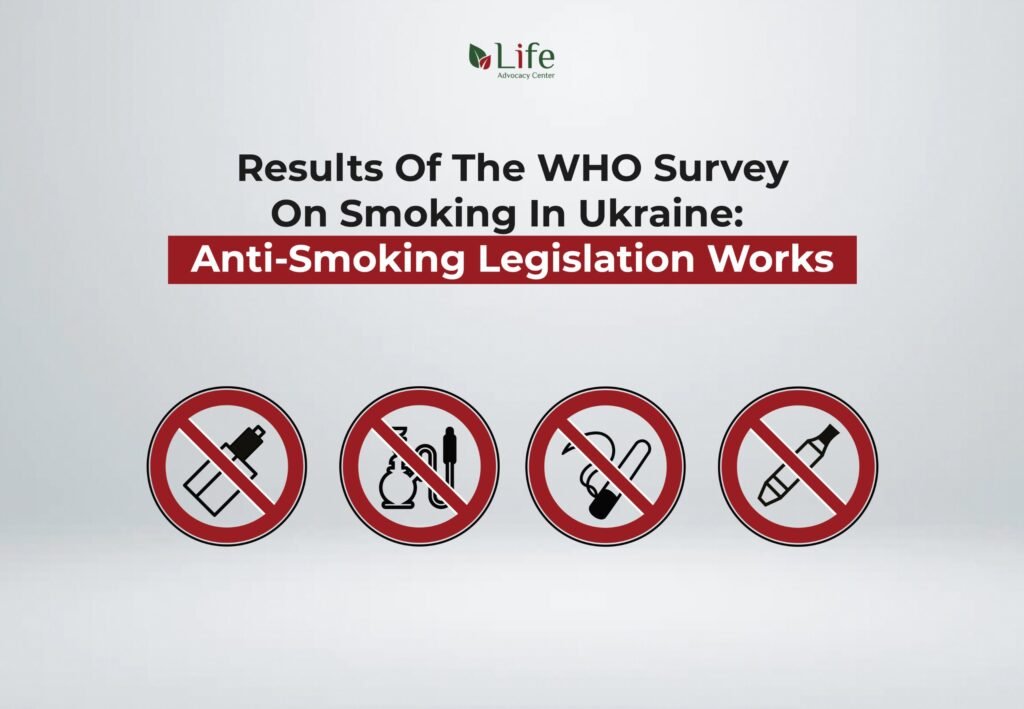The World Health Organization (WHO) has presented the results of a survey of Ukrainian adults on the use of tobacco and nicotine products. NGO “Life” analysed this data and highlighted some key trends: there has been a decline in tobacco and nicotine product use among adults, but, on the contrary, the popularity of new products among young people has increased dramatically.
Key findings (fieldwork – October 2024, April 2023):
- 26% of adults are current users of tobacco and nicotine products, compared to 27% in 2023;
- 22% of the population consumes tobacco or nicotine daily;
- the prevalence of tobacco smoking has decreased (from 27% to 23%), mainly among men;
- conversely, among young people aged 18 – 29, consumption has increased by 16% (from 36% to 42%) due to an increase in the use of new tobacco and nicotine products.

Infographic by WHO
Young people aged 19 – 29 are the age group with the highest prevalence of tobacco and nicotine product use in Ukraine. They most often use:
- 20% – electronic cigarettes (100% increase over 1 year);
- 14% – traditional cigarettes (32% decrease)
- 8% – heated tobacco products (7% increase).
At the same time, flavored tobacco and nicotine products are growing in popularity, with 22% of the population using exclusively flavored products, compared to 15% in 2023. The majority of these users are, once again, young people: 51% of Ukrainians aged 18 – 29 prefer flavored products, as opposed to 30% in 2023 (a 67% increase). Flavored products are also significantly more popular among women – 27%.
Flavorings remain at the top of marketing ploys: over 40% of users of heated tobacco products (HTPs, used with devices like iqos, glo, ploom) and e-cigarettes cite pleasant flavor and aroma as the reasons for starting to use them. Another reason is the ability to use these products in places where smoking is not allowed, while the law prohibits any kind of smoking and use of tobacco products, including hookahs and e-cigarettes, in public places.

Infographic by WHO
At the same time, it is worth noting a positive shift: Ukrainians are increasingly skeptical of the tobacco industry’s deceptive claims about the new tobacco and nicotine products being “less harmful”. Only a small percentage of users cite this as their reason for using HTPs or e-cigarettes, and, compared to 2023, the number of such users has decreased by 61% and 72% respectively.
What The Research Data Shows
- Anti-smoking legislation works
We are seeing a decline in the use of tobacco and nicotine among adults, especially of traditional cigarettes, which are subject to the most comprehensive regulation. This confirms the effectiveness of MPOWER policies. An annual harmonized 20% increase in excise taxes on cigarettes and HTPs, a ban on advertising tobacco and nicotine products, a ban on smoking HTPs in public places, and the introduction of combined health warnings have all helped to halt the rapid growth in their use.
Dmytro Kupyra, program director at NGO “Life” emphasizes: “We are grateful to the Committee on Public Health and the Verkhovna Rada for passing Law No. 1978-IX, which has contributed to positive changes. At the same time, tax and regulatory preferences for HTPs, electronic cigarettes, and nicotine snus are already leading to a rapid increase in their consumption among young people. The lack of appropriate regulatory action will lead to an increase in nicotine consumption and jeopardize the progress achieved in protecting the population from tobacco.“
- The tobacco industry attracts young people using new tobacco and nicotine products, which are less strictly regulated
The aggressive push for new tobacco and nicotine products leads to them gaining popularity among children and the youth. This poses a significant threat: increased morbidity, premature mortality and further worsening of the demographic crisis.
- It is necessary to strengthen the regulation of new tobacco and nicotine products and to effectively monitor compliance with existing regulations.
- Eliminate the 25% excise tax preference for HTPs compared to cigarettes.
- Taking into account the introduction of a new EU directive, adapt the plan to increase excise taxes on tobacco products to €215 per 1,000 items.
- Eliminate marketing tools for promoting tobacco and nicotine products (draft law No. 12091):
- ban flavored tobacco products, including HTPs, in accordance with European Integration Directive 2014/40/EC;
- prohibit the display of tobacco and nicotine products in retail outlets and the advertising of HTP and e-cigarette brands;
- introduce combined health warnings on all tobacco product packaging, including images of the real consequences of tobacco use;
- establish the responsibility of business entities for not allowing state representatives to conduct inspections on compliance with anti-smoking legislation.
- Prohibit the production and sale of electronic cigarettes (draft law No. 13548-4) and initiate a ban on nicotine snus.
For contact information: Olha Masna, media coordinator at NGO “Life”, 073-089-65-70, olha.masna@center-life.org

